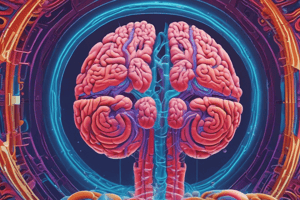Podcast
Questions and Answers
Increasing the matrix size in digital imaging results in a larger pixel size and better spatial resolution.
Increasing the matrix size in digital imaging results in a larger pixel size and better spatial resolution.
False (B)
Each pixel in a digital image with a bit depth of 3 can have 8 different gray levels.
Each pixel in a digital image with a bit depth of 3 can have 8 different gray levels.
True (A)
A voxel in the context of imaging refers to the brightness level assigned to a pixel.
A voxel in the context of imaging refers to the brightness level assigned to a pixel.
False (B)
Higher bit depth in digital imaging results in higher spatial resolution.
Higher bit depth in digital imaging results in higher spatial resolution.
The appearance of a digital image is not affected by the matrix size or the bit depth.
The appearance of a digital image is not affected by the matrix size or the bit depth.
Contrast resolution in digital imaging is influenced by factors such as pixel size and voxel information.
Contrast resolution in digital imaging is influenced by factors such as pixel size and voxel information.
Increasing the matrix size for the same field of view (FOV) will result in larger pixel sizes and poorer spatial resolution.
Increasing the matrix size for the same field of view (FOV) will result in larger pixel sizes and poorer spatial resolution.
A smaller field of view (FOV) without changing the matrix size will lead to larger pixel sizes and better spatial resolution.
A smaller field of view (FOV) without changing the matrix size will lead to larger pixel sizes and better spatial resolution.
The bit depth of an image determines the number of shades of gray, affecting the density resolution.
The bit depth of an image determines the number of shades of gray, affecting the density resolution.
The process of scanning involves dividing the image into an array of pixels.
The process of scanning involves dividing the image into an array of pixels.
Sampling involves converting the analog signal from the photomultiplier into a digital image for computer processing.
Sampling involves converting the analog signal from the photomultiplier into a digital image for computer processing.
Quantization assigns a specific integer value, called a gray level, to the brightness levels obtained during sampling.
Quantization assigns a specific integer value, called a gray level, to the brightness levels obtained during sampling.
Digital images are represented as a collection of discrete pixels or voxels, with each pixel or voxel assigned a numerical value representing its intensity or color.
Digital images are represented as a collection of discrete pixels or voxels, with each pixel or voxel assigned a numerical value representing its intensity or color.
The appearance of digital images, such as sharpness and contrast, is primarily determined by the spatial resolution and bit depth of the imaging system.
The appearance of digital images, such as sharpness and contrast, is primarily determined by the spatial resolution and bit depth of the imaging system.
In digital imaging, spatial resolution is measured in bits per inch (bpi).
In digital imaging, spatial resolution is measured in bits per inch (bpi).
Higher bit depth in digital imaging results in improved contrast resolution and a wider range of displayable intensity or color levels.
Higher bit depth in digital imaging results in improved contrast resolution and a wider range of displayable intensity or color levels.
Voxels are three-dimensional pixels used to represent volumetric data, such as in computed tomography (CT) or magnetic resonance imaging (MRI) scans.
Voxels are three-dimensional pixels used to represent volumetric data, such as in computed tomography (CT) or magnetic resonance imaging (MRI) scans.
In digital imaging, higher spatial resolution always results in better image quality, regardless of the bit depth.
In digital imaging, higher spatial resolution always results in better image quality, regardless of the bit depth.
Flashcards are hidden until you start studying




